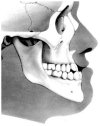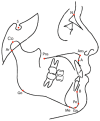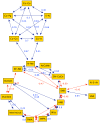Using networks to understand medical data: the case of Class III malocclusions
- PMID: 23028552
- PMCID: PMC3448617
- DOI: 10.1371/journal.pone.0044521
Using networks to understand medical data: the case of Class III malocclusions
Abstract
A system of elements that interact or regulate each other can be represented by a mathematical object called a network. While network analysis has been successfully applied to high-throughput biological systems, less has been done regarding their application in more applied fields of medicine; here we show an application based on standard medical diagnostic data. We apply network analysis to Class III malocclusion, one of the most difficult to understand and treat orofacial anomaly. We hypothesize that different interactions of the skeletal components can contribute to pathological disequilibrium; in order to test this hypothesis, we apply network analysis to 532 Class III young female patients. The topology of the Class III malocclusion obtained by network analysis shows a strong co-occurrence of abnormal skeletal features. The pattern of these occurrences influences the vertical and horizontal balance of disharmony in skeletal form and position. Patients with more unbalanced orthodontic phenotypes show preponderance of the pathological skeletal nodes and minor relevance of adaptive dentoalveolar equilibrating nodes. Furthermore, by applying Power Graphs analysis we identify some functional modules among orthodontic nodes. These modules correspond to groups of tightly inter-related features and presumably constitute the key regulators of plasticity and the sites of unbalance of the growing dentofacial Class III system. The data of the present study show that, in their most basic abstraction level, the orofacial characteristics can be represented as graphs using nodes to represent orthodontic characteristics, and edges to represent their various types of interactions. The applications of this mathematical model could improve the interpretation of the quantitative, patient-specific information, and help to better targeting therapy. Last but not least, the methodology we have applied in analyzing orthodontic features can be applied easily to other fields of the medical science.
Conflict of interest statement
Figures







References
-
- Barabàsi A-L, Oltvai ZN (2004) Network biology: under standing the cell's functional organisation. Nat Rev Genet 5: 101–113. - PubMed
-
- Caldarelli G (2007) Scale-free networks. Complex webs in nature and technology. Oxford: Oxford Univ Press.
-
- Barabasi A-L (2009) Scale-free networks: a decade and beyond. Science 325: 412–413. - PubMed
MeSH terms
LinkOut - more resources
Full Text Sources

